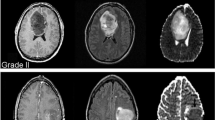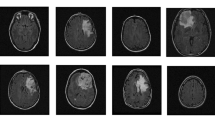Abstract
In the field of computational histopathology, computer-assisted diagnosis systems are important in obtaining patient-specific diagnosis for various diseases and help precision medicine. Therefore, many studies on automatic analysis methods for digital pathology images have been reported. In this work, we discuss an automatic feature extraction and disease stage classification method for glioblastoma multiforme (GBM) histopathological images. In this paper, we use deep convolutional neural networks (Deep CNNs) to acquire feature descriptors and a classification scheme simultaneously. Further, comparisons with other popular CNNs objectively as well as quantitatively in this challenging classification problem is undertaken. The experiments using Glioma images from The Cancer Genome Atlas shows that we obtain \(96.5\%\) average classification accuracy for our network and for higher cross validation folds other networks perform similarly with a higher accuracy of \(98.0\%\). Deep CNNs could extract significant features from the GBM histopathology images with high accuracy. Overall, the disease stage classification of GBM from histopathological images with deep CNNs is very promising and with the availability of large scale histopathological image data the deep CNNs are well suited in tackling this challenging problem.




Similar content being viewed by others
References
Bilgin C, Demir C, Nagi C, Yener B. Cell-graph mining for breast tissue modeling and classification? In: IEEE annual international conference on engineering in medicine and biology society (EMBC); 2007. pp. 5311–5314.
Sertel O, Kong J, Catalyurek UV, Lozanski G, Saltz JH, Gurcan MN. Histopathological image analysis using model-based intermediate representations and color texture: Follicular lymphoma grading. J Signal Process Syst. 2009;55:169.
Gurcan MN, Boucheron LE, Can A, Madabhushi A, Rajpoot NM, Yener B. Histopathological image analysis: a review. IEEE Rev Biomed Eng. 2009;2:47–171.
Marchevsky AM, Wick MR. Evidence-based medicine, medical decision analysis, and pathology. Hum Pathol. 2004;35(10):1179–88.
Boucheron LE. Object-and spatial-level quantitative analysis of multispectral histopathology images for detection and characterization of cancer. Ph. D. dissertation, University of California, Santa Barbara, CA; 2008.
Rodenacker K, Bengtsson E. A feature set for cytometry on digitized microscopic images. Anal Cell Pathol. 2003;25:1–36.
Tamaki K, Fukuma K, Kawanaka H, Takase H, Tsuruoka S, Aronow BJ, Chaganti S. Comparative study on feature descriptors for brain image analysis. In: Proceedings of the IEEE international conference on and advanced intelligent systems (ISIS), 2014; pp. 679–682.
Prasath VBS, Fukuma K, Aronow BJ, Kawanaka H. Cell nuclei segmentation in glioma histopathology images with color decomposition based active contours. In: IEEE international conference on bioinformatics and biomedicine (BIBM), 2015; pp. 1734–1736.
Fukuma K, Prasath VBS, Kawanaka H, Aronow BJ, Takase H. A study on nuclei segmentation, feature extraction and disease stage classification for human brain histopathological images. In: 20th international conference on knowledge based and intelligent information and engineering systems (KES), 2016; pp. 1202–1210.
Fukuma K, Kawanaka H, Prasath VBS, Aronow BJ, Takase H. A study on feature extraction and disease stage classification for glioma pathology images. In: IEEE international conference on fuzzy systems (FUZZ-IEEE). 2016; pp. 2150–2156.
Huang JY, Hughes NJ, Goodhill GJ. Segmenting neuronal growth cones using deep convolutional neural networks. In: IEEE international conference on digital image computing: techniques and applications (DICTA); 2016.
Fu C, Ho D J, Han S, Salama P, Dunn KW, Delp EJ. Nuclei segmentation of fluorescence microscopy images using convolutional neural networks. In: IEEE 14th international symposium on biomedical imaging (ISBI); 2017.
Astrom K, Heyden A. Semantic segmentation of microscopic images of H&E stained prostatic tissue using CNN. In: IEEE international joint conference on neural networks (IJCNN); 2017.
Shi P, Zhong J, Huang R, Lin J. Automated quantitative image analysis of hematoxylin–eosin staining slides in lymphoma based on hierarchical K means clustering. In: IEEE 8th international conference on information technology in medicine and education (ITME); 2016.
Lim ST, Ahmed MK, Lim SL. Automatic classification of diabetic macular edema using a modified completed Local Binary Pattern (CLBP). In: IEEE international conference on signal and image processing applications (ICSIPA); 2017.
AbuHassan KJ, Bakhori NM, Kusnin N. Automatic diagnosis of tuberculosis disease based on Plasmonic ELISA and color-based image classification. In: IEEE 39th annual international conference on engineering in medicine and biology society (EMBC); 2017.
NIH The Cancer Genome Atlas (TCGA). https://cancergenome.nih.gov/. Accessed 28 May 2018.
Yonekura A, Kawanaka H, Prasath VBS, Aronow BJ, Takase H. Glioblastoma multiforme tissue histopathology images based disease stage classification with deep CNN. In: The 6th international conference on informatics, electronics & vision (ICIEV); 2017.
Long J, Shelhamer E, Darrell T. Fully convolutional networks for semantic segmentation. In: IEEE CVPR; 2015. pp. 3431–3440.
Ciresan D C, Giusti A, Gambardella L M, Schmidhuber J. Mitosis detection in breast cancer histology images with deep neural networks. In: MICCAI; 2013. pp. 411–418.
Iqbal S, Khan MU, Saba T, Rehman A. Computer-assisted brain tumor type discrimination using magnetic resonance imaging features. Biomed Eng Lett. 2018;8(1):5–28.
Prasath VBS. Deep learning based computer-aided diagnosis for neuroimaging data: focused review and future potential. Neuroimmunol Neuroinflammation. 2018;5:1.
Ronneberger O, Fischer P, Brox T. U-Net: Convolutional networks for biomedical image segmentation. In: MICCAI; 2015. pp. 234–241.
Greenspan H, van Ginneken B, Summers RM. Deep learning in medical imaging: overview and future promise of an exciting new technique. IEEE Trans Med Imaging. 2016;35(5):1153–9.
Mansour RF. Deep-learning-based automatic computer-aided diagnosis system for diabetic retinopathy. Biomed Eng Lett. 2018;8(1):41–57.
Kassim YM, Prasath VBS, Glinskii OV, Glinsky VV, Huxley VH, Palaniappan K. Microvasculature segmentation of arterioles using deep CNN. In: IEEE international conference on image processing (ICIP); 2017. pp. 580–584.
Yonekura A, Kawanaka H, Prasath VBS, Aronow BJ, Takase H. Disease stage classification for Glioblastoma Multiforme histopathological images using deep convolutional neural network. In: Joint 17th world congress of international fuzzy systems association and 9th international conference on soft computing and intelligent systems (IFSA-SCIS); 2017.
TensorFlow. https://www.tensorflow.org/. Accessed 28 May 2018.
Yonekura A, Kawanaka H, Prasath VBS, Aronow BJ, Takase H. Improving the generalization of disease stage classification with deep CNN for glioma histopathological images. In: International workshop on deep learning in bioinformatics, biomedicine, and healthcare informatics (DLB2H); 2017. pp 1222–1226
Lecun Y, Bottou L, Bengio Y, Haffner P. Gradient-based learning applied to document recognition. In: Proceedings of the IEEE; 1998. pp. 2278–2324.
Zeiler M, Fergus R. Visualizing and understanding convolutional networks. In: Proceedings of ECCV; 2014.
Simonyan K, Zisserman A. Very deep convolutional networks for large-scale image recognition. In: Proceedings of ICLR; 2015.
Krizhevsky A, Sutskever I, Hinton GE. ImageNet classification with deep convolutional neural networks. In: Proceedings of NIPS; 2012. pp. 1097–1105.
Author information
Authors and Affiliations
Corresponding author
Ethics declarations
Conflict of interest
The author declares that there is no conflict of interest.
Ethical statement
This article does not contain any studies with human participants or animals performed by any of the authors.
Rights and permissions
About this article
Cite this article
Yonekura, A., Kawanaka, H., Prasath, V.B.S. et al. Automatic disease stage classification of glioblastoma multiforme histopathological images using deep convolutional neural network. Biomed. Eng. Lett. 8, 321–327 (2018). https://doi.org/10.1007/s13534-018-0077-0
Received:
Revised:
Accepted:
Published:
Issue Date:
DOI: https://doi.org/10.1007/s13534-018-0077-0




